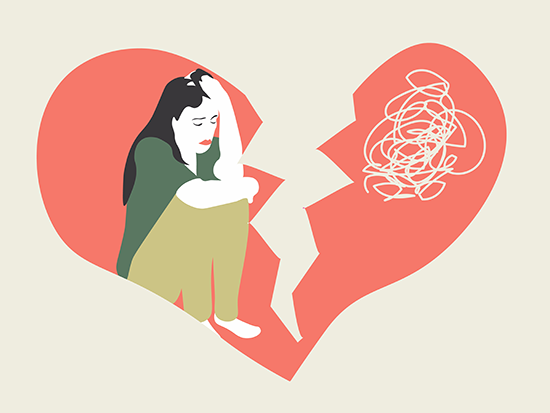
It is possible to have a broken heart, though not in the way people typically think. While many people think of a broken heart on an emotional level, Gregory Chapman, M.D., a cardiologist in the University of Alabama at Birmingham Cardiovascular Institute, says a broken heart can impact the body on a physical level, causing temporary cardiac episodes or, in rare cases, even death.
Broken heart syndrome is a common name for stress-induced cardiomyopathy, or takotsubo cardiomyopathy, a disease that causes severe swelling of the left ventricle. Because the swollen ventricle looks so much like a clay pot used by Japanese fishermen to trap octopi, Japanese researchers named the condition in 1990 after a tako-tsubo pot.
What causes it
Although the exact cause of stress-induced cardiomyopathy is unknown, it is known that stress triggers its symptoms. Situations such as the sudden loss of a loved one, being fired from a job, an automobile accident, sudden extreme illness, domestic violence, or experiencing immediate danger, loss, and/or injuries from a natural disaster such as a tornado or hurricane might prompt this condition.
According to a study published in 2020, the coronavirus pandemic’s beginning also saw broken heart syndrome cases rise substantially. Chapman says this is most likely due to the stress communities went through during this time.
What to look for
Signs and symptoms of the condition are almost identical to those of a heart attack and may include sudden chest pain, shortness of breath and an irregular heartbeat. People who have broken heart syndrome usually do not have any heart disease symptoms before they are diagnosed.
The current data strongly suggest that broken heart syndrome occurs when stress hormones, such as adrenaline, surge into the heart, triggering changes in muscle cells and blood vessels. Those changes prevent the left ventricle from properly contracting.
As cardiomyopathy worsens, the weakened heart becomes less able to pump blood or maintain a normal electrical rhythm. The result can be heart failure or irregular heartbeats, known as arrhythmias. A weakened heart also can cause other complications, such as heart valve problems.
How it is diagnosed
Chapman says diagnosing broken heart syndrome can be a challenge.
“Takotsubo looks like a heart attack,” Chapman said. “It presents all the typical symptoms, and you could argue that, in a way, it is a kind of heart attack. The only way to know that it’s not a typical one is through examination and tests in a catheter lab, where we can determine by angiogram if the arteries are blocked. Once we see that the arteries are normal, but the left ventricle has severely ballooned out, we may diagnose stress-induced, or takotsubo, cardiomyopathy.”
Chapman’s book, “A Strong & Steady Pulse: Stories from a Cardiologist,” details his experience in treating and teaching medical students about various heart conditions, with one chapter dedicated to broken heart syndrome. Click here to learn more.
Who is at risk
Chapman says those with mental health conditions such as depression, as well as those who have already had this type of cardiomyopathy, are more likely to develop broken heart syndrome.
A 2021 study by the Smidt Heart Institute reported that over 80 percent of broken heart syndrome cases recorded occurred in women. The study also reported that women 50 years old and older are particularly at risk for this condition. Middle-aged women have the highest risk. Hormones are the reason behind this, according to Chapman.
How to treat it
Procedures that are often used to treat a heart attack are not effective treatments for broken heart syndrome. The standard treatment of this cardiomyopathy involves the use of medications that manage its symptoms and effects. Initial recovery takes place with a hospital stay. For about 90 days after the hospital stay, patients will take the same medications used to treat congestive heart failure to support and strengthen the heart.
Most affected people quickly recover with no permanent damage to the heart muscle, with most patients recovering within 30 to 90 days. Stress-induced cardiomyopathy is seldom fatal but causes heart failure in about 20 percent of patients. Rarely reported complications include arrhythmias, or abnormal heart rhythms, obstruction of blood flow from the left ventricle and rupture of the ventricle wall.
How to prevent it
Staying relaxed is the best way to prevent broken heart syndrome, according to Chapman. “As hard as it is, try to avoid stressful situations,” Chapman said. “Since this kind of cardiomyopathy is stress-induced, keeping your stress levels as low as possible can help prevent this syndrome.”
Stress management techniques such as physical activity, setting boundaries and more may help. For these and more stress management tips, click here.
Source: UAB News
